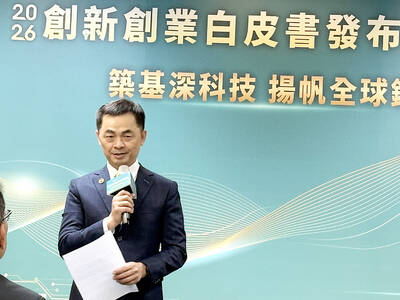Intel Corp, Microsoft Corp and the technology companies that so far have escaped the credit crisis relatively unscathed will lose out on as much as US$170 billion in sales next year as the crunch catches up with them.
Corporate spending on computers, software and communications equipment may be little changed or fall as much as 5 percent next year as the lending freeze spooks clients, said Jane Snorek, an analyst at First American Funds in Minneapolis who has followed the industry for 13 years. It would be the first decline in the US$3.41 trillion market since 2001 after the dot-com bubble burst.
“Business kind of stopped dead in the last two weeks,” said Snorek, whose firm owns Microsoft and Intel stock among more than US$100 billion in assets. “People are pushing off orders and saying, ‘I have no idea if we’re going to have a global meltdown, so I’m not going to buy anything right now.’”
While consumer spending growth slowed this year as the economy slumped, corporate budgets stayed fairly constant until now. Snorek said the collapse of financial-services customers, who account for a quarter of technology outlays, and a subsequent surge in interest rates persuaded clients to pare back.
More data was to have emerged yesterday when Intel, whose chips run more than three-quarters of the world’s personal computers, kicks off two weeks of third-quarter reports from technology companies. Software maker SAP AG said last week orders froze last month, and a Forrester Research Inc survey found clients pressing outsourcing and services providers to renegotiate at lower rates.
In 2001, technology spending sank 7 percent, UBS AG said. The reason Snorek estimates that next year’s slump won’t be as bad as that is that companies have less inventory built now than they did in 2000 and 2001.
Gartner Inc said on Monday that spending growth would slow to 2.3 percent next year in a “worst-case scenario,” down from its earlier projection of 5.8 percent, while iSuppli Corp last week cut its forecast for this year’s global semiconductor revenue growth to 3.5 percent from 4 percent, saying the industry faces “significant potential downside” if the economic slump deepens.
Intel may post its lowest sales increase in six quarters, reporting 2 percent growth to US$10.3 billion, the average of 30 analysts’ estimates shows. Profit probably rose to US$0.34 a share, the survey found.
“We’re seeing the beginning of the end,” said JPMorgan Chase semiconductor analyst Chris Danely in San Francisco. “For the fourth quarter, I think they’ll guide lower. Then the first quarter is a total disaster.”
Microsoft, which reports on Friday next week, may say profit increased to US$0.47 a share last quarter on a 7.6 percent sales gain to US$14.8 billion, the survey showed. Analysts anticipate that earnings per share will rise to US$0.56 and that sales will climb to US$18.3 billion in the current quarter.
Microsoft projects that sales in the year ending in June will climb 11 percent to at least US$67.3 billion. Slowing growth in PC shipments may hamper that effort, Morgan Stanley analyst Adam Holt in San Francisco said last week. He cut his estimate for Microsoft to US$65.3 billion, an 8 percent increase.
Dozens of technology companies will report results in the next two weeks, including Apple Inc and chipmakers Broadcom Corp and Advanced Micro Devices Inc.
“I would expect to see some misses that will raise red flags and ultimately could be the beginning of the slowdown that so far has eluded the tech industry,” said Jason Pompeii, a Chicago-based technology analyst for Fitch. “We could really start to see the effects of the broader economy.”

CHIP RACE: Three years of overbroad export controls drove foreign competitors to pursue their own AI chips, and ‘cost US taxpayers billions of dollars,’ Nvidia said China has figured out the US strategy for allowing it to buy Nvidia Corp’s H200s and is rejecting the artificial intelligence (AI) chip in favor of domestically developed semiconductors, White House AI adviser David Sacks said, citing news reports. US President Donald Trump on Monday said that he would allow shipments of Nvidia’s H200 chips to China, part of an administration effort backed by Sacks to challenge Chinese tech champions such as Huawei Technologies Co (華為) by bringing US competition to their home market. On Friday, Sacks signaled that he was uncertain about whether that approach would work. “They’re rejecting our chips,” Sacks

NATIONAL SECURITY: Intel’s testing of ACM tools despite US government control ‘highlights egregious gaps in US technology protection policies,’ a former official said Chipmaker Intel Corp has tested chipmaking tools this year from a toolmaker with deep roots in China and two overseas units that were targeted by US sanctions, according to two sources with direct knowledge of the matter. Intel, which fended off calls for its CEO’s resignation from US President Donald Trump in August over his alleged ties to China, got the tools from ACM Research Inc, a Fremont, California-based producer of chipmaking equipment. Two of ACM’s units, based in Shanghai and South Korea, were among a number of firms barred last year from receiving US technology over claims they have

BARRIERS: Gudeng’s chairman said it was unlikely that the US could replicate Taiwan’s science parks in Arizona, given its strict immigration policies and cultural differences Gudeng Precision Industrial Co (家登), which supplies wafer pods to the world’s major semiconductor firms, yesterday said it is in no rush to set up production in the US due to high costs. The company supplies its customers through a warehouse in Arizona jointly operated by TSS Holdings Ltd (德鑫控股), a joint holding of Gudeng and 17 Taiwanese firms in the semiconductor supply chain, including specialty plastic compounds producer Nytex Composites Co (耐特) and automated material handling system supplier Symtek Automation Asia Co (迅得). While the company has long been exploring the feasibility of setting up production in the US to address

OPTION: Uber said it could provide higher pay for batch trips, if incentives for batching is not removed entirely, as the latter would force it to pass on the costs to consumers Uber Technologies Inc yesterday warned that proposed restrictions on batching orders and minimum wages could prompt a NT$20 delivery fee increase in Taiwan, as lower efficiency would drive up costs. Uber CEO Dara Khosrowshahi made the remarks yesterday during his visit to Taiwan. He is on a multileg trip to the region, which includes stops in South Korea and Japan. His visit coincided the release last month of the Ministry of Labor’s draft bill on the delivery sector, which aims to safeguard delivery workers’ rights and improve their welfare. The ministry set the minimum pay for local food delivery drivers at